The Otway Forests
The forests of the Otway Ranges have a story that is at least as complex as any in Victoria - from the early days of sleeper cutting in blue gum forests around Apollo Bay, to the inroads and uses, and misuses, by encroaching settlers, to a sawlog harvesting history of more than 150 years, to inappropriate and disastrous settlements inside the forest boundaries, to plantations developed on failed settlements and, in common with all of Victoria's forests, repeated and damaging wildfires.
This article is an attempt to provide the tools to let you begin to explore that story. It is based on the early records of visitors and government agencies, but the greatest input comes from publications by Norman Houghton and Roger Smith, and videos produced by Jim Speirs.
A map of sawmill sites, tramlines and other features is also available via the link below. It brings together the maps in Norman Houghton's books - Sawdust and Steam (2011) and Choppers and Chippers (2018). There is also a timeline map of sawmills present by 5 year periods. Neither map would be available in this form without Norman's initial work, but also his significant work to attribute dates to the occupation of the sawmill sites.
Overview
The table and other information below is taken from:
The Redwoods of the Otway Ranges. Roger Smith. 2015
"Of the 350,000 hectares of native vegetation that covered the Otways 150 years ago, only 160,000 hectares of public land remain as native forest. And of the 160,000 hectares of public native forest that exist today, almost all of the merchantable eucalypt forest has been logged over at least once, sometimes more often. The only exceptions are two small patches of Mountain Ash, one in the West Barham River and the other in Olangolah Creek."
"When the hands and feet of European man made their mark on the wet mountain forests, the changes in the way the forest was used to benefit the incoming communities were profound. These changes, over a period of 175 years, are summarised in the following timeline."
1840s
1850s
1860s
1870s
1880s
1890s
1900s
1910s
1920s
1930s
1940s
1950s
1960s
1970s
1980s
1990s
2000s
2010s
& beyond
The Forest & Settlement
What must have been one of the earliest descriptions of the Otway Forests was published in:
1851
"On reaching the shores of this ‘Newest World,' we make our first excursion into the country, eager to behold an aboriginal forest, and to get a definite idea of what ' The Bush,' of which we have heard so much, really is. Here we find a great deal that is beautiful and characteristic verdant glades, rich play of light and shade, grotesque old trees, abundance of artistic studies; but the primeval forest of our dreams is as far as ever from realisation."
"Yet such a forest really exists, and that within a couple of days' ride from Port Phillip Bay. The Promontory of Cape Otway, broken up into steep declivities, shelving valleys, and beetling precipices, is wholly covered by a dense forest of ‘innumerous boughs,' of sun-proof shades, of tangled mazes ... "
"There are two ways by which you may reach Cape Otway. Taking the northerly route, you first go to an outstation of Mr. Roadknight, near the sources of the Barwon, about fifty miles distant from Geelong, and thence by Roadknight's Track, through the heart of the forest, to Apollo Bay, a distance of forty miles; whence a tortuous track, again turning inland, conducts to the Cape and the Lighthouse. Following the second or southern route you first make the coast at Carter's Station, thence continue along or near the beach, to Loutit Bay (twelve miles,) and so on to Apollo Bay, sometimes by the beach, and, where this is impracticable, turning inland, traversing one or more spurs of the hills, and so returning to the beach."
"Every green shrub had been devoured by the flame. On all sides were gigantic trees, tall, and running up a hundred feet without throwing off a single branch. The trunks were completely charred externally, the flames having reached up perhaps a hundred feet, as they fed upon the undergrowth, but the loftiest tops appeared to have escaped. The tops, however, were lost in cloud and mist, so that accurate observation was impossible. Nothing could be more desolate and cheerless. It was too dreary, too monotonously wild even for Salvator Rosa and his bandits. But the difficulties in our path soon engrossed all attention. The track, formerly well-defined and easy, was now almost effaced; to follow it was out of the question, for it often lay beneath a chaos of huge fallen trunks and branches intertwined. Often it became necessary to make a long detour to avoid these prostrate Goliaths of the Forest, which, two or three hundred feet long, would occasionally arch over a ravine, and leave a passage beneath."
"The main point of interest in this wonderful forest is the magnificent growth and almost incredible size of the trees. Some that we roughly measured were fifty and sixty feet in circumference, five feet from the ground. From thirty to forty feet was perhaps the average girth. Even the lightwood climbed to a height of a hundred feet. The larger trees are generally hollow near the roots: sometimes the interior forms a vast cave. They stand straight and erect as fir-trees, and give the forest somewhat of is Alpine character. In some, the exterior takes the form of graceful Gothic moldings, and remind you of majestic Cathedral nave. The colossal limbs and roots, often assume the most grotesque and bizarre forms. All the foliage is at the summit, and thus enjoys the influences of light and sunshine and wind."
"It was noticeable that, over the tract of country where the trees had been so thinned out by man, there was not a sufficient growth of young eucalyptus trees to supply the place of those removed. This fact is observable throughout the colony to a greater or less degree; and it is evident that where the eucalyptus is gradually removed, and the soil is covered with a dense undergrowth, assistance by clearing and sowing must be rendered to cause to exist a succession of young trees to take the place in time of those removed. How different the result after the passage of a clean-sweeping bush fire is apparent on inspection of parts of this came forest which have been unfortunately exposed to its effects. On such parts the young eucalyptus trees stand only too thickly, are grown into shapely young trees, and only require protection from future fires of sufficient strength to sweep them out of existence to restore the forest in time to its pristine condition."
"The summit of Mount Sabine is the northern boundary of the course of this destructive fire. From here some idea of the amount of destruction can be obtained. The ranges to the east and to the west and the country passed through to the south have all been submitted to its ravages, whilst north of the east and west line there is no appearance of the effects of fire but one great extent of magnificent forest. To the north of Mount Sabine the forest is equal to anything in the colony, probably inferior to parts of the Victoria Forest in the size of the trees, but of greater value as growing the more valuable bluegum. Both the bluegum and the stringybark are in great perfection on this slope of the mount, and the forest here must become of immense value if protected from fire-as soon as communication is opened up with the settled parts of the colony."
The Royal Commission established in 1897 published a report on the Otway Forests in:
1899
Ref 3The quotes below all come from that report.
The Forest
"It is doubtful whether in any other part of the colony there is to be found such a variety of valuable timber trees as in the Otway peninsula. Among those of the eucalyptus family are the bluegum, grey or spotted gum, mountain ash or blackbutt, messmate, two kinds of stringybark, and whitegum, all of which are widely distributed, and in the north-eastern part the red ironbark. In addition to these there are interspersed among the higher forest trees valuable beds of blackwood, evergreen beech, olive, sycamore, satin box, and pencil wood."
"The bluegum, which has for many years been cut in the Apollo Bay district and shipped to Melbourne, is of the finest quality, being exceedingly dense and hard in the grain. It is said by the merchants who deal in it to be fully equal to the best Tasmanian timber of the same kind. The greygum, also a heavy and close-grained wood, is now largely, cut by the mills established in the Barramunga district, and, in addition to being employed in building and construction, is used in coachbuilders' and wheelwrights' work as a substitute for bluegum. The mountain ash, of which there are still immense supplies, is being utilized in the neighbourhood of the Forrest railway for palings and laths, as well as for sawmill timber, while the messmate, which extends in belts along the eastern side of the Main Dividing Range, and over an extensive tract northward of the Upper Gellibrand, furnishes an exceedingly durable and useful timber, in great request in the western district for building and fencing material. Of the furniture and veneering woods for which the forest is noted, the blackwood was reported on by the Railway Timber Board so far back as the year 1884 as of, the finest quality for carriage building."
"As to the size of the largest timber, nowhere in the colony save perhaps, near the Black Spur above Healesville, at the head of the River Yea, and in the Neerim district, are trees of such great height and girth found as in the gorges and sheltered valleys of this forest. There may still lie seen on the Apollo Bay track, a short distance eastward of Ditchley Park, the shell of a dead mountain ash, the branches and upper trunk of which have long been consumed by fire, which at a height of 5 feet from the ground measured 73ft. 6in. in girth."
"In the same parish he took the measurements of a fine symmetrical mountain ash which was lying prostrate; the length was 329 feet to a point at which the top was broken off by the fall, the diameter 4 feet at 16 feet from the base end, the girth 3ft. 6in. at a height of 255 feet, and 2ft. 6in. at 328 feet." "As regards blackwood, it is in the heart of the Otway Forest that this valuable tree appears to attain its greatest development, although the beds are not so extensive as those found in Western and Southern Gippsland. On the River Aire about 4 miles south of Ditchley Park, the valuer of the shire of Colac measured a blackwood, which was 19ft. 6in. in girth at a height of 5 feet. It had a perfectly straight stem, and was apparently sound. Another tree in the same parish Olangolah which was, felled some years ago for the purpose of sending the timber to an exhibition at Ballarat, measured 4ft. 6in. in diameter at a height of 18 feet from the ground, the stem running to a height of 80 feet without a branch and tapering in that length only 6 inches."
"The timber in the north-eastern part of the forest (southward of Wensleydale) is to a large extent of inferior quality, but from the parish of Boonah, in a southwesterly direction along the Main Dividing Range, it gradually improves. Some of the finest belts of mountain ash and greygum in the colony are found in the parishes of Barramunga and Kaanglang the area of 36,000 acres known as the Barwon Water Reserve. From this reserve, extending across the range into the parish of Wongarra in a south-easterly direction, there is a large area of very fine timber, chiefly blue and greygum, messmate, and mountain ash.".
Settlement Impacts
"The extent of the destruction of timber caused by selectors on their holdings in the tract known as the Beech Forest, within the bounds of the shire of Colac, is estimated at 60,000 acres, or nearly half the total area occupied there. The destruction of mountain ash and spotted gum in some parts is simply appalling. On scores of selections immense numbers of young trees, the growth of the past fifty years, which for height and proportion could not he surpassed elsewhere in the colony,' running as they do without a branch from 120 to 200 feet, have been ringed in the face. Nearly the whole of this extensive area was taken up (in many cases by people who had never seen the land) under the Section 32nd of the Land Acts 1881-90, at an annual rental of 2d. an acre, one of the provisions of the permits being that the occupiers should only destroy crooked or useless timber and scrub, a condition which has apparently been interpreted by the Crown Lands Department and its bailiffs to mean all timber, even if, as in the case of the Barramunga forest, £80 to £100 an acre has been fixed as a fair estimate of the value of the milling and splitting trees on some of the holdings."
"Regarded from every point of view, the manner in which settlement in this forest has been not only permitted but encouraged has been a great administrative blunder. The State has allowed a large number of people (many of them, with insufficient capital) to enter upon an immense virgin forest, the cost of roughly clearing which is simply ruinous to them. In the absence of a railway and proper roads, they cannot grow crops at profit; they therefore simply kill the trees and. sow grass for the pasturage of cattle. The destruction committed by them in making homes for themselves has been put in a very emphatic, if exaggerated, way by sawmillers in the district, who say that the value of the timber so destroyed, "would have paid the national debt."
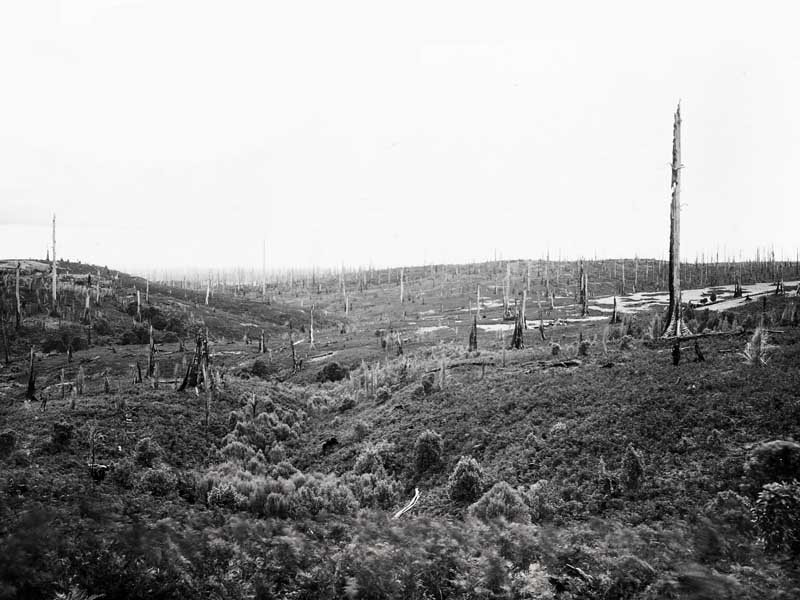
Condition of forest, near Beech Forest, following clearing and wildfire
Probably early 1900s
Source: FCRPA
Further information can be found in notes extracted from material provided by N Houghton.
Forest Production
Sawmills and Sawlogs
"The State Forest available for sawmilling from 1897 was one fashioned by bushfire, natural regeneration cycles and land selector clearing. Available evidence indicates that the forest was not a neat and steady stand of even aged mid-term trees but a variable patchwork of stands, some young, some mid-aged and some ancient. Major unrecorded bushfires in the 18th century, plus 1851, 1886, 1898, 1919, 1926 and 1939 determined the state of much of the forest covered in this history." 7
"Starting in 1945 from virtually nothing the FCV over the next 20 years constructed 300 km of all-weather roads and 220 km ofjeep tracks in the Otways." 5
"Throughout the 150-year period between 1850 and 2000, over 320 sawmills either operated in or were supported by the Otways at various times and most were situated within the forest." 6
"During this period between 1850 and 2000, it is estimated that over 10,000,000 cubic metres of roundwood in the form of sawlogs, pulplogs, poles and posts have been harvested from the Otway native forests." 6
Output from native forests peaked in 1961, with 27 sawmills cutting 119,000 cubic metres of sawlogs." 6
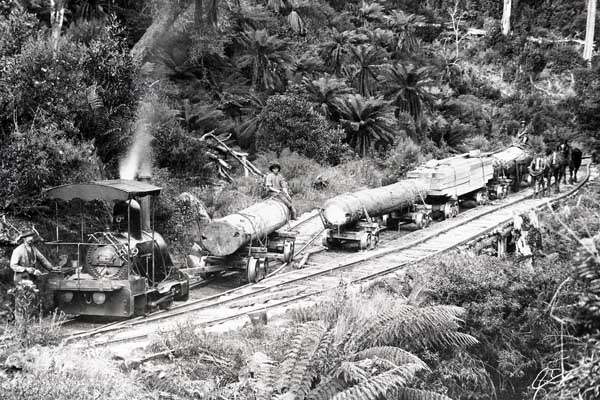
0-4-0 Well Tank Locomotive No.7 at work on Henry's tramway, south of his No. 1 Mill
Abt late 1890s to early 1900s
Source: FCRPA

Log landing at a winch site on Wild Dog Creek Road, Otways
1950
Photo:VP Cleary Source: G Cleary
There are 311 sawmill sites shown on the site map, but N Houghton believes there are probably quite a few more he has been unable to locate. There are approximately 470km of tramline.
Sleepers
Around Apollo Bay (once named Middleton):
"From 1854 until 1861 the timber industry thrived on railway contracts for sleepers to build the Melbourne—Geelong and the Geelong—Ballarat railways, but once this trade ceased, and for shipping difficulties as well, the settlement of Middleton declined. Timber dispatch depended on wind and season to a great degree and the occurrence of several shipwrecks caused shipping masters to shun Apollo Bay, and as there was 'no other means of getting the timber away the mills had to be abandoned, the tramways were pulled up and the engines and plant were removed and the once thriving township was allowed to vanish from sight. Only one family of settlers remained out of a population that had numbered almost 1000 during one period." 7
-Firewood
"Production figures are hard to come by but the evidence suggests that around 6,000 plus cubic metres per year came out ofthe West Otways State Forest and probably a similar amount from private blocks for most years from 1910 to the 1940s." 5
Split Timbers
"Split products such as palings, mining timbers and sleepers originally came from Barongarook, Kawarren, Gellibrand and Irrewillipe (to a lesser extent) in the period l875 to 1902." 5
"Once the Beech Forest railway opened in 1902 the bulk of palings and mining timbers were increasingly derived from Ferguson and Olangolah rather than the foothill forests. On the east side of Beech Forest towards Olangolah there stood massive stands of mountain ash, even aged regrowth from the 1851 bushfire. These long-grained timbers in tall and clean trunks were easy to work with hand tools and produced a quality product, some saying as good as the sawn stuff. 5
"The outputs at Olangolah were amazing. One splitter was observed in 1907 to have cut 6,000 palings and 4,000 fruit case boards from a single tree." 5
Beams/Bridge Timbers/Mining Timbers/Posts/Poles
Production figures for these forest products are not available, but the volumes would have been considerable.
Split Timbers
"Split products such as palings, mining timbers and sleepers originally came from Barongarook, Kawarren, Gellibrand and Irrewillipe (to a lesser extent) in the period l875 to 1902." 5
"Once the Beech Forest railway opened in 1902 the bulk of palings and mining timbers were increasingly derived from Ferguson and Olangolah rather than the foothill forests. On the east side of Beech Forest towards Olangolah there stood massive stands of mountain ash, even aged regrowth from the 1851 bushfire. These long-grained timbers in tall and clean trunks were easy to work with hand tools and produced a quality product, some saying as good as the sawn stuff. 5
"The outputs at Olangolah were amazing. One splitter was observed in 1907 to have cut 6,000 palings and 4,000 fruit case boards from a single tree." 5
Charcoal
"During the Second World War charcoal production became a vital activity for the war effort as a substitute for rationed petrol when motor vehicles were modified to run on charcoal gas. Such was the demand that in 1942 the FCV opened an ultra-modern charcoal burning plant on the Tomahawk Creek at lrrewillipe to supply the increased needs of Colac and district." "The annual output was more than 3,500 tonnes. The site was remote and isolated so the workers camped on site. The plant worked to the end of the war." 5
The charcoal site is located on the map referred to earlier.
Wildfire and Salvage
Wildfires and efforts to salvage valuable timber go hand in hand - the Otways was no different in that respect.
"In the aftermath of fires the FCV organised salvage and repair. Some of these salvage assessments were heartbreaking for the Foresters. For instance, Forester Firth subrmitted the following report on the 1919 fire : "Over 60000 acres were burnt and over 100 homes destroyed. The north wind blew with terrific force and the fire fairly raced up the steep slopes to the top of the Otway Range. Practically the whole of the damage was done in three or four hours, and during that time the fires travelled for miles. The fire that caused the greatest destruction started at the back of Walsh's and McKinlay's allotment in the parish of Moomowroong and swept through the whole of the unoccupied Crown lands between these allotments and the top of the range, and reaching to top had a face of several miles, extending from Stalker to Wattle Hill. The fire destroyed in addition to sawmills, at least 800 ha of valuable mountain ash, messmate and gum on the Crown lands. At a conseryatiye estimate this would have yielded a total of 60 million supe feet of timber. This timber has been killed outright and after three or four years will be practically valueless for building timber." 5
The Impacts
"Where did all this timber go? A fair portion of it went up in smoke and as natural decay at the end of its useful life. This applied to firewood that was burnt in thousands of hearths and stoves from Geelong to Warrnambool and in hundreds of factory boilers in butter factories, abattoirs, woollen mills, hospitals, gold mines etc. The fence posts, rails and palings served their time in thousands of kilometres of farm and domestic fencing until burnt by bushfires or naturally decaying and being replaced. The packaging such as barrels, butter boxes, fruit boxes, machinery cases, pallets etc. delivered their contents and have been burnt as rubbish. The bridge, pier and jetty piles, beams and sleepers have decayed or been eaten by marine worms or termites. The mining laths and props lined hundreds of kilometres of drives and shafts in mines from Pitfield to Ballarat to Maryborough. Most of it is still there, entombed in watery graves and gave rise to the quip by Otway timbermen that there is more Otway timber underground than above it. The decorative timbers largely survive in items of furniture and panelling and floorboards in fine houses. The bulk of East Otway milled timber ended up in house frames and as weatherboards. The majority of timber houses built from the 1890s to the 1960s from Geelong to Warrnambool and in parts of the Wimmera and Mallee have Otway frames. Ditto for the original weatherboards and mouldings." 7
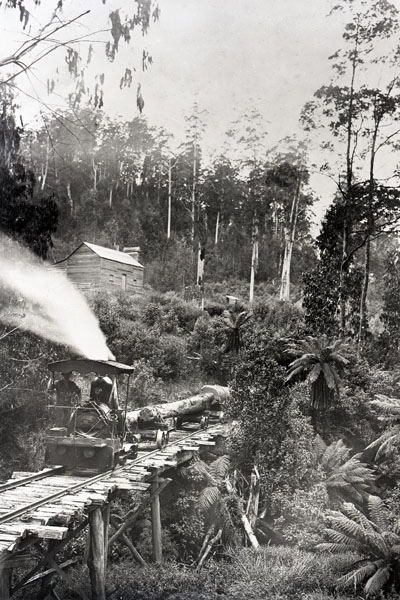
Beyer Peacock 0-4-0 locomotive on JH Henry's 3ft6in gauge tramway near his Barwon Mill, south of Forrest.
Abt 1910
Source: FCRPA
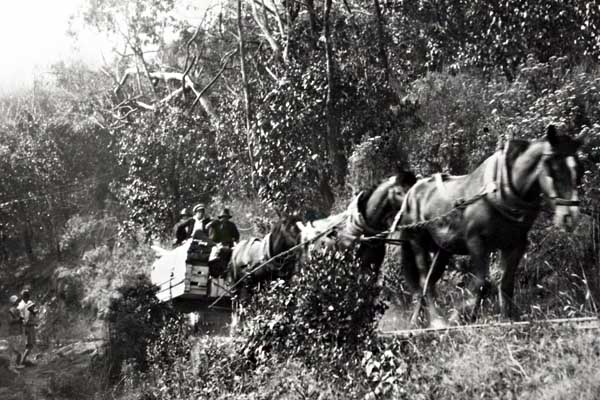
Photograph probably taken in the early 1900s (Source: FCRPA) : Sawn timber being hauled to Lorne Pier - St George River side of Teddy's Lookout.
Probably early 1900s
Source: FCRPA
J Speirs et al - Videos
Two film records of the Otway forests since European settlement are available below.
Plantations
Although this article concentrates on the hardwood forests of the Otways, it wouldn't be complete
without acknowledgement of the reforestation program which originated on failed farmland.
"Large scale commercial plantations in the West Otways were initiated by the Forests Commission of Victoria (FCV) at Beech Forest as part of its softwoods policy for import substitution and supplementation of native hardwoods. The West Otways was seen as an ideal growing region for exotic pines owing to it being a temperate rain forest environment. The selection of particular ground for planting was determined by the number of abandoned agricultural allotments around Beech Forest. The Aire Valley was chosen as the first site and the FCV began acquiring abandoned blocks there from 1929." 4
"The Aire Valley plantations covered the upper tributaries of the Aire River, including Farrells Creek, Nigger Creek, Flannagan Creek, Pulpit Creek, Walsh Creek, Beech Creek, Deppler Creek, Congram Creek and Hazel Creek. The plantation also covered part of the upper reaches of the Barham River (Seaview Creek and Falls Creek) and the headwaters of Clearwater Creek. These are some of the wettest areas of plantation in Victoria and they displayed exceptional early growth of Pinus radiata. 6
"Other conifer species planted on a commercial scale at the Aire Valley Plantation included Picea sitchensis (Sitka spruce) in 1930-37, Pinus muricata (Bishop pine) in 1931-38, Pinus nigra (Corsican pine) in 1930-38, Pinus ponderosa (Western yellow pine) in 1930-35, Pseudotsuga taxifolia (Douglas fir or Oregon pine) in 1930-37, and Sequoia sempervirens (Californian redwood) in 1929-36." 6
J Speirs et al - Video
"In the early 1880s, significant areas of the heavily-forested Otway Ranges were made available for ‘selection’, and conversion to farmland. Over the following decades much forest was removed but, for reasons that included the vigorous native vegetation, high rainfall, poor access, and bushfires, many of these farms failed. In the early 1920s the FCV, on behalf of the government, started buying back these lands with a view to returning them to forest. With a national softwood shortage, some areas, including parts of the Aire Valley, saw the establishment of tree species from the northern hemisphere.
By the end of Government involvement in the management of plantations in this region, the area of plantation established was about 3800ha.
This film, which was produced by former FCV Overseer, and Shire Councillor Jim Spiers in 2005, examines the establishment of the original plantations, and the industries that these days are based on them." (Description from YouTube Video.)
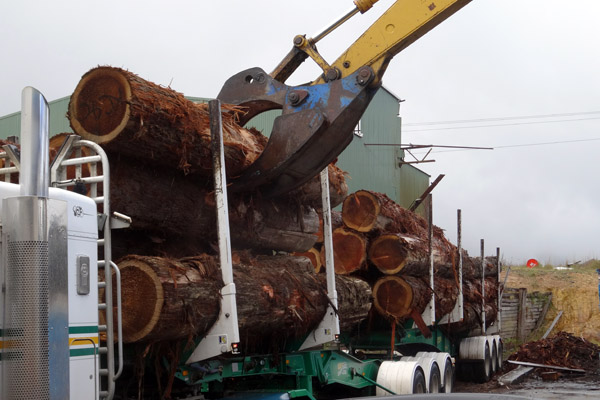
Redwood sawlogs from the FCV Aire Valley plantings of the late 1920s-early 1930s at a Woodend sawmill. "Specialty timber products have been cut from Sequoia sawlogs for many years now, starting with the 1929 plantings at Depplers Creek." Roger Smith, September 2021
Source: D Endacott
Forester Frank Smith was one of the architects of the reforestation program.
The link below will take you to a screenshot from Google Maps taken on 4 February 2022. It will provide an indication of the location of the early reforestation plantations.
You may also be interested in the Strzelecki Reforestation Project.
References
1 The Black Forest of Victoria. Extract from Vol 1 No 3 of "The Australasian Magazine, published on 28 April 1851 by John Pullar of Melbourne.
2 Cape Otway State Forest. Extract from Papers relating to Forest Conservancy Published by Dept Crown Lands, 17th Dec 1874.
3 The Otway Forest - Its Resources, Management and Control.Fifth Progress Report of the Royal Commission on State Forests and Timber Reserves. 1899
4 West Otway Plantations. N Houghton (2014). Newsletter No. 62, Australian Forest History Society Inc.
5 Choppers & Chippers A History of the Timber Industry in the West Otway Ranges. N Houghton. 2018
6 The Redwoods of The Otway Ranges. Roger Smith. 2015
7 Sawdust and Steam. A History of Sawmilling in the East Otway Ranges. 1850-2010. Norman Houghton. 2011
See Also
Old Beechy (Extracts) - N Houghton 1992
Timber Production in the Otway Forests. LB Williams. Abt 1976
Otway Timber Mills & Pioneering Days. GA Facey. 1977
Getting Logs to the Mill. N Houghton. 1995
Sawmilling in the Otways & at Tanjil Bren. J Mackie. 1980
Otway State Forest abt 1879.
East Otway Memories. Reg Wilson. 1994
Extract - Forrest Reminiscences. C Hutchinson
Beech Forest FCV Staff. N Houghton
Sawmilling in the Otways
Vacation in the Otways - 1968
The Otway Forests - NRE 1998
Barongarook Sawmills - N Houghton
A Chronology of Forest and Land Use in Victoria
Wensleydale Wood
Wye River - Timber Harvesting & Sawmilling
Otway Forest Closure - Media Release 2002
